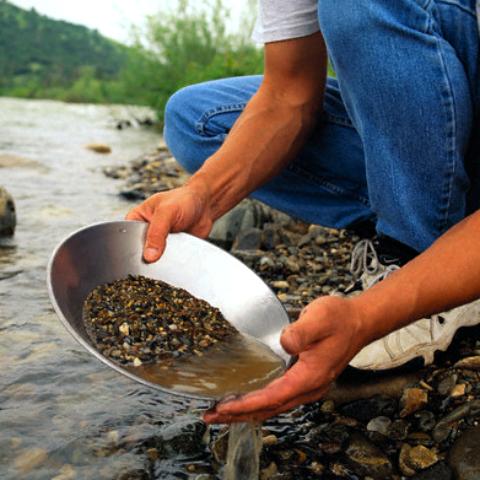Try GOLD PANNING
 The basic principles of panning for gold are the same today as they were the prospectors of old. Even the gold pans used today are very similar in design to those used many years ago. Although some people have tried to sell different shaped pans as being more efficient the fact is that the popular round gold pan is all you need.
The basic principles of panning for gold are the same today as they were the prospectors of old. Even the gold pans used today are very similar in design to those used many years ago. Although some people have tried to sell different shaped pans as being more efficient the fact is that the popular round gold pan is all you need.Today gold pans are made of plastic which makes them much lighter and easier to transport and use. They are also usually a dark colour which makes the gold stand out better against the pan so you are less likely to spill gold without noticing. Some gold pans have raised riffles to help trap the gold, while other pans have indented grooves that do a similar job. There are mechanical pans also, many of these are used more for separating the gold from the concentrates rather than as a prospecting tool.
The art of gold panning is not one that requires a degree. Anyone with a little instruction and some practice will be able to pan gold with the best of them in no time. Possibly the biggest hurdle to overcome is the fear that you will loose the gold if you are not very careful. Most gold is actually pretty hard to shake from the pan if you are using a reasonable gold panning technique. A more skilled gold panner will not so much capture more gold per pan as they will pan out a pan full much quicker. Neither should a person be disheartened heading out to rivers that have been mined in the past when trying their luck at gold panning. It said that the early gold miners only recovered about 10 percent of the worlds gold so there are still many gold bearing areas yet to be mined. But even rivers that the old timers did work were left with gold in them.
The equipment that miners used in the past was often very rudimentary and spilled as much gold as it recovered. They especially lost the fine gold. On top of that, gold is also being continually uncovered by floods, seismic activity, and volcanic activity.
GOLD PANNING SECRETS. The biggest secret to gold panning is locating gold rich material to put in your pan. The best gold panner in the world can not extract gold from material that has no gold in it. Once you have studied geological charts, gold mining history in your area, or even if you are just heading out to try your luck, there are things you should look for to improve your chances. Finding exposed bedrock, the hard rock bottom, is always a sign that if there is any gold in the river you will get some in your pan.
Look for crevices or potholes in the bedrock that contain sand, and hopefully gold, to put in your pan. Black sand is often associated with gold so any backwash or beach of black sand is worth exploring for gold deposits. Also, any large boulder or obstruction in the river is a trap for gold as flood waters boil over it. Just remember the sage wisdom that gold is where you find it. Just because gold is often found with black sand do not limit yourself to black sand deposits, as gold is also found in pure clay and the bottom of swamps.
HOW TO PAN GOLD:
1. Fill your pan ? full of river gravel and hold it just below the surface of the water. Your aim is to wash away the mud, clay, gravel, sand etc. but retain whatever gold is mixed with this material.
2. Shake the pan from side to side – this will raise any large rocks to the surface where they may be picked out with your fingers and thrown away (make sure they aren’t nuggets of gold!).
3. After shaking, progress to gentle circular movement so that the material in your pan moves in a circular motion. As the material moves it is lifted from the base of the pan and is carried away by the flowing water. The gold, being far heavier, works its way to the bottom of the pan.
4. Once the material in your pan has been reduced to lighter gravel and sand, tip the pan away from you slightly and continue your circular swirling to move this finer material out over the edge of the pan.
5. A slight forward tossing motion may be added at this stage, but take care – you don’t want to wash away gold along with the debris. If you see gold or black sand appearing around the edges of your material and working its way forward just wash all the material back to the bottom of your pan and start again.
6. When you have only a couple of handfuls of material left in your pan, lift it out of the river. Keeping about 2cms of water in the pan, continue washing until you have removed all remaining debris. Now, if you’re lucky, the only thing left in your pan will be…gold!